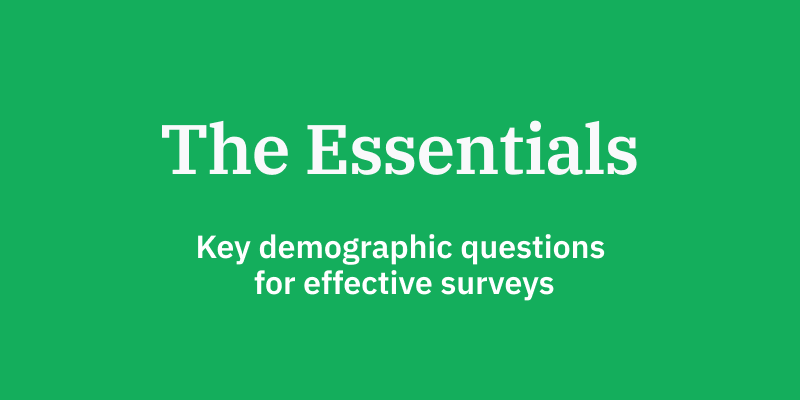Table Content

Collecting generic data nowadays is simply not enough to ensure business success anymore. It is not just about acquiring and managing big data any longer, but having data at hand ready to enable a positive customer experience.
The key to increasing user satisfaction and creating a positive customer experience is segmentation and personalization of data to maximize service relevance for each individual customer.
This segmentation which precedes any personalized addressing of customers requires defining the criteria to segment by, such as demographic data in order to better determine who your customers or prospects truly are.
If you are running a survey with one of the aforementioned target audiences, it is vital to ask the right demographic questions in order to maximize your understanding of this data.
In the following sections, we will take a look at the best demographic questions to ask and how to ask them in surveys.
What Demographic Data to Collect in Surveys
Naturally, not every survey should contain all conceivable demographic questions. The process of selecting and writing demographic questions is always strongly case-dependent and should be chosen based on research strategy and goals. Therefore, make sure to explicitly define the purpose of your data acquisition beforehand and you will be on the right track.
Nevertheless, a certain basic set of demographic data will always be helpful in segmenting survey research data in order to get to know your main prospects or customers.
What is your age?
The art of asking about a respondent’s age is balancing the level of data detail as well as avoiding survey fatigue, i.e., grouping individual ages into ranges leads to fewer answer options, improves readability and possibly lowers response fatigue.
How finely you choose to distinguish between age groups should be tested for comparison of response rates.
It is important to work with a single-choice question format such as a radio list question type, as these answer options need to be mutually exclusive. Also, make sure that your age ranges don’t overlap, otherwise, your data evaluation will be difficult.
Here’s an example of how you could structure the question:
o Under 18 years old
o 18 – 24 years old
o 25 – 34 years old
o 35 – 44 years old
o 45 – 54 years old
o 55 – 64 years old
o 65 – 74 years old
o 75+ years old
What is your gender?
Asking about a person's gender has become an increasingly sensitive topic, as apart from male and female gender attribution, multiple alternative gender descriptions have arisen recently that have been recognized as official gender statements.
LimeSurvey offers a prebuilt button style or radio list gender question type. It, however, only includes male and female as answer options so far. If additional gender options are to be included, a simple radio list question type will do. Also, a simple open-ended question type can be used to give respondents the ultimate freedom in choosing their gender identification.
Here’s a preview of possible questions regarding the sex/gender of your test person:
o Female
o Male

What is your marital status?
Learning about respondents’ marital status is often one of the less important demographic questions, as this segmentation does not usually deliver significant value to the majority of most businesses.
Nevertheless, there are plenty of benefits of gaining information from this data, especially since it is a fairly straightforward question. It makes sense to enable multiple choice question types in this case, as a combination of answer options is possible, e.g., someone who is single could also be recently separated from a meaningful relationship.
Here is an example of how to ask for marital status:
o Single
o Married or domestic partnership
o Widowed
o Divorced
o Separated
o Other
How would you specify your ethnicity?
Questions about ethnicity, race, or origin are highly sensitive in nature due to conflicts and crises that have shaped society through past events and prejudices.
Nevertheless, the data derived from this question is popular to segment survey responses in order to derive trends and patterns in regard to cultural impact.
As this is not a mere aspect of documentation, but also based on belief systems and emotional identification, you should use a multiple-choice question type to help ensure that respondents have multiple options to choose from depending on how they identify.
This example could be used as a template for the question:
o African American
o White
o Hispanic or Latino
o Native American
o Asian
o Other
What is the highest educational level you have achieved?
Receiving data on respondents’ qualifications is a great way to analyze the educational impact on answers given in your survey.
Make sure to provide a complete and distinct list of qualification levels here to cover any possible situation. Usually, answer options involving degrees can be thought of as mutually exclusive, as they build on each other in a hierarchical structure when asking about specifying the highest qualification, so you should use a radio list question type here.
o Less than high school or secondary school degree
o High school or secondary school degree
o Bachelor's degree
o Master's degree or diploma
o Doctorate
o Other
What is your annual gross household income?
Similar to the age question presented above, income questions can face the problem of survey fatigue depending on how detailed, and thus how many answer options are presented at once. Categorizing income in ranges will again help reduce the available options and make it more transparent.
Make sure to use a currency that is recognized globally to improve the comprehensibility and comparability of answer options, e.g., U.S. dollars or EURO.
As money is always a sensitive topic, it is recommended that if you are not in desperate need of this data to make the income question a voluntary one, as many people do not like giving information on their personal finances.
o Less than €30.000
o €30.000 to €49.999
o €50.000 to €69.999
o €70.000 to €89.999
o €90.000 to €99.999
o €100.000 or more
What is your current employment status?
If you are questioning a wide variety of people, getting information on their employment status can be very interesting and valuable.
The difficulty with this question, however, is to provide all possible occupational statuses. Listing a few common ones and offering an Other option, however, should solve the problem. Make sure to use a multiple-choice question here since people can have different occupational statuses at the same time, e.g., a student can also be employed part-time or self-employed.
o Employed full-time (40 or more hours per week)
o Employed part-time (up to 39 hours per week)
o Unemployed
o Self-employed
o Unable to work
o Retired
o Student
o Other
Which industry do you work in?
This is an optional question and obviously will only be relevant if the aforementioned question was answered with a full-time, part-time or self-employment response.
This is also a tricky one, as you may use a single or multiple-choice question type and have a very long list of industries which may lead to survey fatigue, or you could offer an open-text question which will significantly increase the amount of time it takes to complete the survey.
A great approach here would be to create a question that works with search recognition, a hybrid of the aforementioned options in a manner that allows the respondent to start typing in an open-text field, and based on this, offers predefined answer options that will standardize the results to be evaluated later on. This, however, will require coding expertise.
Leverage the Value That Demographic Data Can Deliver
Firstly, you need to align your questions with your research goals and strategy by choosing the necessary demographic questions and phrasing them in a way that they are appropriate and meaningful.
Secondly, you need to make sure not to overload your respondents with too many demographic questions at the same time. So you have to find a good balance between getting enough data for your research requirements and not having too many questions, which might cause your respondents to abandon your survey before completion.

